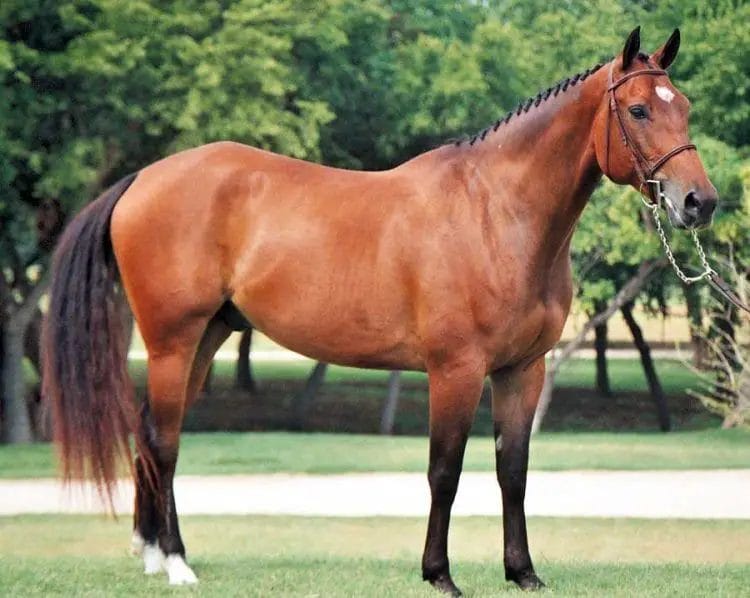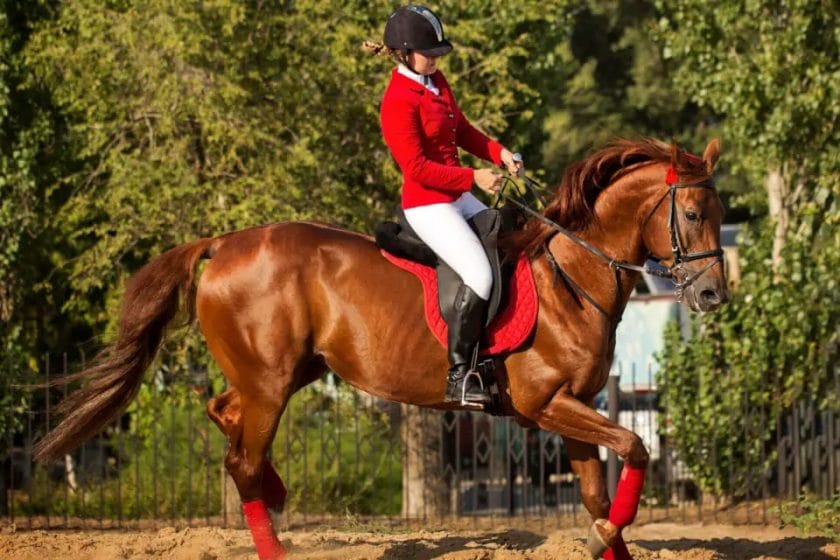If you are a rider or enthusiast who loves the smooth and graceful movements of gaited horses, then you have come to the right place. Whether it’s the elegant paso fino or the spirited Tennessee walking horse, we understand your passion for these unique and versatile breeds. Our platform is dedicated to all things gaited horses, offering valuable information, tips, and a community of like-minded individuals. Join us as we dive into the world of gaited horses and explore the joys of riding and caring for these remarkable animals.

Different Gaited Horse Breeds and Their Unique Characteristics
Gaited horses are a special group of equines that possess a smooth and distinctive way of moving. Unlike regular horses that primarily rely on the traditional walk, trot, and canter gaits, gaited horses can perform additional gaits called “ambling gaits.” These gaits are known for their smoothness and can be incredibly comfortable for riders. In this section, we will explore some of the different gaited horse breeds and discuss their unique characteristics.
Tennessee Walking Horse
The Tennessee Walking Horse is a popular gaited breed known for its gentle disposition and smooth gaits. One of the most distinctive traits of this breed is the “running walk.” This four-beat gait is smooth and effortless, making it a favorite among pleasure riders and trail enthusiasts. The Tennessee Walking Horse is also known for its natural head nodding motion, which adds elegance to its movements.
Another unique feature of the Tennessee Walking Horse is its versatility. It can perform various gaits, including the flat walk and the canter, while still maintaining its smoothness. This breed is often seen in show competitions, where its beauty, grace, and exceptional gait are showcased.
Racking Horse
The Racking Horse is another gaited breed that originated in the United States. It is renowned for its ability to perform the “rack,” a fast and smooth four-beat gait. The rack is often described as a more extended version of the running walk, allowing the horse to cover considerable ground while providing a comfortable ride for the rider.
One of the standout features of the Racking Horse is its natural talent for performing the rack. With minimal training, these horses can effortlessly transition into this smooth gait and maintain it for extended periods. Due to their elegant movements and willingness to please, Racking Horses are often used for both pleasure riding and showing.
Icelandic Horse
The Icelandic Horse is a small yet mighty gaited breed hailing from Iceland. Known for its sure-footedness and endurance, this horse is highly cherished by its native people and is an important part of Icelandic culture. The Icelandic Horse can perform several gaits, including the “tolt” and the “flying pace.”
The tolt is a four-beat lateral gait that is incredibly smooth and comfortable. It allows the rider to experience a gliding sensation, making long-distance riding a joy. On the other hand, the flying pace is a high-speed gait where the horse moves both legs on the same side simultaneously. This gait can reach breathtaking speeds and is often seen in Icelandic horse racing events.
Paso Fino
The Paso Fino is a gaited breed originating from the Caribbean and is recognized for its elegant movements and versatility. This breed can perform three main gaits: the “paso fino,” the “paso corto,” and the “paso largo.”
The paso fino is a smooth and collected four-beat gait, known for its cadence and precision. It is often described as a “fine step” and provides a comfortable ride for the rider. The paso corto is similar to the paso fino but has a slightly faster tempo, while the paso largo is a ground-covering gait that allows the horse to cover more distance with each stride.
Paso Finos are highly admired for their exceptional trainability and gentle nature. They are versatile horses that excel in various disciplines such as pleasure riding, trail riding, and dressage.
Gaited Breeds: A Unique Riding Experience
These are just a few examples of the diverse gaited horse breeds that offer riders a unique and pleasurable riding experience. Whether you are looking for a smooth and comfortable trail companion or a stunning show horse, gaited breeds can provide both style and substance. Each breed has its own special characteristics and gaits, ensuring that riders can find the perfect match for their riding preferences. So, saddle up and embark on a ride filled with elegance, comfort, and the joy of gaited horses!

Training Techniques for Gaited Horses: Enhancing Their Natural Gaits
Gaited horses possess a unique characteristic of having natural gaits that are different from the typical walk, trot, and canter of other horse breeds. These natural gaits, such as the running walk, rack, and paso fino, are smooth and comfortable for both the rider and the horse. However, it is important to train gaited horses properly to enhance and refine their natural gaits. In this section, we will explore some effective training techniques that can help improve the natural gaits of gaited horses.
Understanding the Natural Gaits
Before delving into the training techniques, it is essential to have a good understanding of the natural gaits of gaited horses. Each gaited breed has its own distinct gaits, and it is crucial to recognize and identify these gaits correctly. Observing the horse in motion and studying the desired gait in detail will enable trainers to better understand the mechanics and characteristics of each gait.
Furthermore, it is important to note that gaited horses have various natural gaits and can perform different gaits depending on their breed and individual abilities. Identifying the horse’s natural gaits will allow trainers to work with the horse’s innate abilities and improve upon them.
Establishing a Solid Foundation
When training gaited horses, it is crucial to start with a solid foundation. This involves establishing basic ground manners, respect, and obedience from the horse. Groundwork exercises such as leading, lunging, and desensitization can help build trust and develop a strong foundation between the trainer and the horse.
In addition to groundwork, it is also important to ensure that the horse is physically fit and sound before beginning gait training. Regular exercise and conditioning, along with proper nutrition and healthcare, are essential for the horse’s overall well-being and performance.
Developing Balance and Collection
Balance and collection play a vital role in enhancing the natural gaits of gaited horses. These two aspects help the horse achieve a more efficient and rhythmic movement. Exercises such as circles, serpentines, and lateral movements can aid in developing balance, flexibility, and suppleness in the horse’s body.
Furthermore, working on transitions between gaits can help the horse find its natural rhythm and balance. Starting with slower gaits and gradually progressing to faster ones can allow the horse to develop a smooth and flowing gait sequence.
Utilizing Specific Gait Training Techniques
There are several specific training techniques designed to enhance the natural gaits of gaited horses. These techniques focus on teaching the horse to perform its natural gaits with more precision and consistency.
One such technique is the use of ground poles. Placing poles on the ground at specific intervals can encourage the horse to lift its legs higher and engage its hindquarters, resulting in a more pronounced and distinct gait. Gradually increasing the distance between the poles can further challenge the horse and improve its gait.
Another technique is the use of lateral exercises, such as leg yields and shoulder-in. These exercises help the horse develop better coordination and balance, which in turn enhances its natural gaits. By asking the horse to move sideways or diagonally, trainers can encourage the horse to engage specific muscle groups and achieve greater balance and collection.
Consistency and Patience
When training gaited horses, consistency and patience are key. It is important to maintain a regular training schedule and provide clear and consistent cues to the horse. Reinforcing desired behaviors and rewarding the horse for correct responses will help in the training process.
Additionally, patience is essential when working with gaited horses. Each horse is unique and may progress at its own pace. Some horses may require more time and repetition to develop their natural gaits, while others may pick up the training quickly. Understanding and respecting the individuality of each horse will lead to more successful training outcomes.
Training gaited horses to enhance their natural gaits requires a combination of understanding their unique characteristics, establishing a solid foundation, developing balance and collection, utilizing specific training techniques, and maintaining consistency and patience throughout the process. By applying these training techniques and principles, gaited horse trainers can help their horses achieve more refined and impressive natural gaits.

Choosing the Right Tack and Equipment for Gaited Horses
When it comes to riding gaited horses, choosing the right tack and equipment is essential to ensure their comfort, safety, and overall performance. Gaited horses have unique movement patterns, and using appropriate gear can enhance their natural gaits while providing the necessary support and control for the rider. In this section, we will explore the key factors to consider when selecting tack and equipment for gaited horses.
Horse’s Conformation
The first consideration in choosing tack for gaited horses is understanding the horse’s conformation. Each gaited breed may have slightly different conformational characteristics, and it is crucial to select gear that fits the individual horse properly. An ill-fitting saddle or bridle can cause discomfort and even physical issues for the horse.
Start by assessing the horse’s back shape, width, and length to find a saddle that distributes the rider’s weight evenly. Gaited horses often have shorter backs, so a shorter saddle with adequate wither clearance is recommended. Look for a saddle with sufficient padding and a design that allows freedom of movement for the shoulders and hindquarters.
Similarly, the bridle should fit well without causing any pinching or discomfort. Consider the horse’s head shape and choose a bridle with appropriate sizing and width. The bit should be selected according to the horse’s training level and mouth sensitivity.
Gait Enhancement
The main reason riders choose gaited horses is for their smooth and unique gaits. To enhance and maintain these gaits, there are specific types of equipment that can be used:
- Gaited Horse Saddle: Gaited horse saddles are designed with features that accommodate the horse’s movement. They often have a higher gullet and wider bars to provide sufficient clearance and support. Look for saddles with flared or gaited bars that allow the horse to lift its shoulders freely.
- Bits: There are various bit options available for gaited horses, such as shank bits, curb bits, or even bitless bridles. The choice of bit depends on the horse’s training, responsiveness, and the rider’s preference. It’s important to select a bit that encourages the horse’s natural gait without compromising control.
- Gaited Horse Shoes: For gaited horses that need additional support and protection, special shoes designed for gaited breeds can be beneficial. These shoes are often lightweight and provide traction and comfort for the horse during their specific gaits.
Rider’s Comfort and Control
The comfort and control of the rider should not be overlooked when choosing tack for gaited horses. A comfortable and secure riding experience allows the rider to maintain balance and communicate effectively with the horse. Consider the following:
- Saddle Fit for the Rider: While the horse’s comfort is essential, the rider’s comfort should also be prioritized. Ensure that the saddle provides adequate support and cushioning for the rider. Additionally, the seat size and stirrup length should be appropriate for the rider’s body type and riding style.
- Reins: Select reins that offer a good grip and allow for clear communication between the rider and the horse. Different materials, such as leather or rubber, can provide varying levels of grip and flexibility. Choose reins that feel comfortable and secure in the rider’s hands.
- Stirrups: The type and length of stirrups can impact the rider’s stability and balance. Choose stirrups that are wide enough to support the rider’s weight and provide a secure foothold. Consider adjustable stirrups that allow customization for the rider’s preference.
Regular Maintenance and Adjustments
Once you have chosen the right tack and equipment for your gaited horse, it is essential to regularly maintain and adjust them. Check the fit of the saddle and bridle periodically, as a horse’s conformation may change over time. Keep the gear clean and in good condition to ensure its longevity and functionality.
Remember, the well-being and performance of your gaited horse rely on the proper selection and use of tack and equipment. By considering the horse’s conformation, focusing on gait enhancement, prioritizing rider comfort and control, and maintaining the gear regularly, you can enhance the overall riding experience
Common Health Issues and Care Tips for Gaited Horses
Gaited horses are known for their smooth and unique gaits, which set them apart from other horse breeds. While these horses are often admired for their elegance and grace, they can still be prone to certain health issues. It’s important for gaited horse owners to be aware of these common health problems and take appropriate care to ensure the well-being of their horses.
1. Lameness
Lameness is a common issue that can affect gaited horses. It can be caused by various factors, including injuries, arthritis, and hoof problems. Regular hoof care, such as trimming and shoeing, is essential to prevent lameness. It’s also important to provide adequate exercise and avoid excessive strain on the horse’s joints. If lameness is observed, it’s crucial to consult a veterinarian for a proper diagnosis and treatment plan.
2. Colic
Colic refers to abdominal pain and can be life-threatening for horses. Gaited horses are not exempt from this condition. Common causes of colic in horses include digestive problems, obstructions, and changes in diet. To prevent colic, ensure that your gaited horse has a balanced and nutritious diet, provide clean and fresh water at all times, and avoid sudden changes in feeding routine. Regular veterinarian check-ups are also important to identify any potential digestive issues early on.
3. Respiratory Issues
Gaited horses, like any other horse breed, can be susceptible to respiratory problems such as allergies, infections, and heaves. Dusty environments, poor ventilation, and exposure to irritants can exacerbate these conditions. To promote good respiratory health, provide a clean and well-ventilated living environment for your gaited horse. Avoid exposing them to dusty or moldy bedding and hay. Regular vaccinations and deworming can also help prevent respiratory infections.
4. Skin Conditions
Some gaited horses may be prone to certain skin conditions, such as rain rot, sweet itch, and dermatitis. These conditions can cause discomfort and affect the horse’s overall well-being. To prevent and manage skin issues, keep your horse’s living environment clean and dry. Regular grooming, including bathing and brushing, can help maintain healthy skin. If your gaited horse develops any skin abnormalities, seek veterinary advice for proper diagnosis and treatment.
5. Hoof Problems
The hooves of gaited horses are critical for their smooth gaits. Hoof problems, such as laminitis and thrush, can greatly affect the horse’s movement and overall health. Regular hoof care, including trimming, cleaning, and proper shoeing, is essential to prevent and address hoof issues. A well-balanced diet and regular exercise also contribute to healthy hooves. If you notice any abnormalities or lameness related to the hooves, consult a knowledgeable farrier or veterinarian.
Care Tips for Gaited Horses
In addition to addressing common health issues, gaited horses require regular care and attention to ensure their overall well-being. Here are some care tips specifically tailored for gaited horses:
1. Regular Exercise
Gaited horses benefit from regular exercise to maintain their muscle tone and promote overall health. Incorporate a balanced exercise routine that includes both riding and free movement in a pasture or paddock.
2. Proper Tack Fit
Ensure that the saddle, bridle, and other tack items fit properly and do not cause discomfort or pain to the horse. Ill-fitting tack can lead to gait irregularities and discomfort.
3. Balanced Diet
Provide a well-balanced diet that meets the nutritional needs of your gaited horse. Consult with a veterinarian or equine nutritionist to determine the appropriate feed and supplements for your horse’s specific requirements.
4. Regular Veterinary Check-ups
Schedule regular check-ups with a veterinarian to monitor your gaited horse’s health and address any potential issues early on. This includes dental care, vaccinations, and deworming.
5. Adequate Shelter
Ensure that your gaited horse has access to appropriate shelter from extreme weather conditions such as heat, cold, and rain. This can be in the form of a stable, run-in shed, or suitable turnout area.
In summary, while gaited horses possess unique gaits that make them stand out, they are still susceptible to common health issues that can
FAQs
Do you post on a gaited horse?
Posting is a riding technique used primarily in trotting horses. Gaited horses, on the other hand, have different types of gaits that do not involve a traditional trot. Instead of posting, riders of gaited horses usually sit or have a different type of movement in the saddle that corresponds to the horse’s gait.
Conclusion:
Wrapping Up
In conclusion, riding a gaited horse can be a thrilling experience. Whether you are a beginner or an experienced rider, the smooth and comfortable gait of these horses can enhance your overall riding enjoyment. The unique four-beat movement of gaited horses, such as the Tennessee Walking Horse or Paso Fino, provides a luxurious and effortless ride that sets them apart from other horse breeds.
Not only does riding a gaited horse offer a more comfortable experience, but it also opens up a world of opportunities for various equestrian activities, such as trail riding, endurance riding, or even show competitions. Gaited horses’ exceptional ability to cover long distances and maintain a steady pace makes them well-suited for these activities.
So, if you are looking for a horse with a smooth and elegant gait, consider exploring the world of gaited horses. Their unique way of moving will undoubtedly leave you wanting more.
